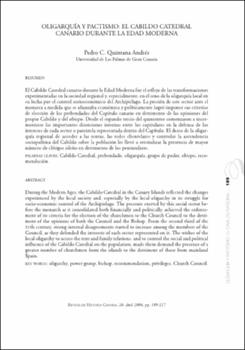Oligarquía y pactismo: el Cabildo Catedral Canario durante la edad moderna
Fecha
2004Resumen
El Cabildo Catedral canario durante la Edad Moderna fue el reflejo de las transformaciones
experimentadas en la sociedad regional y, especialmente, en el seno de la oligarquía local en
su lucha por el control socioeconómico del Archipiélago. La presión de este sector ante el
monarca a medida que se afianzaba económica y políticamente logró imponer sus criterios
de elección de los prebendados del Capítulo canario en detrimento de las opiniones del
propio Cabildo y del obispo. Desde el segundo tercio del quinientos comenzaron a incrementarse
las importantes disensiones internas entre los capitulares en la defensa de los
intereses de cada sector o parentela representada dentro del Capítulo. El deseo de la oligarquía
regional de acceder a las rentas, las redes clientelares y controlar la ascendencia
sociopolítica del Cabildo sobre la población les llevó a reivindicar la presencia de mayor
número de clérigos isleño en detrimento de los peninsulares. During the Modern Ages, the Cabildo Catedral in the Canary Islands reflected the changes
experienced by the local society and, especially by the local oligarchy in its struggle for
socio-economic control of the Archipielago. The pressure exerted by this social sector before
the monarch as it consolidated both financially and politically, achieved the enforcement
of its criteria for the election of the churchmen to the Church Council to the detriment
of the opinions of both the Council and the Bishop. From the second third of the
XVth century, strong internal disagreements started to increase among the members of the
Council, as they defended the interests of each sector represented on it. The wishes of the
local oligarchy to access the rent and family relations, and to control the social and political
influence of the Cabildo Catedral on the population, made them demand the presence of a
greater number of churchmen from the islands to the detriment of those from mainland
Spain.





